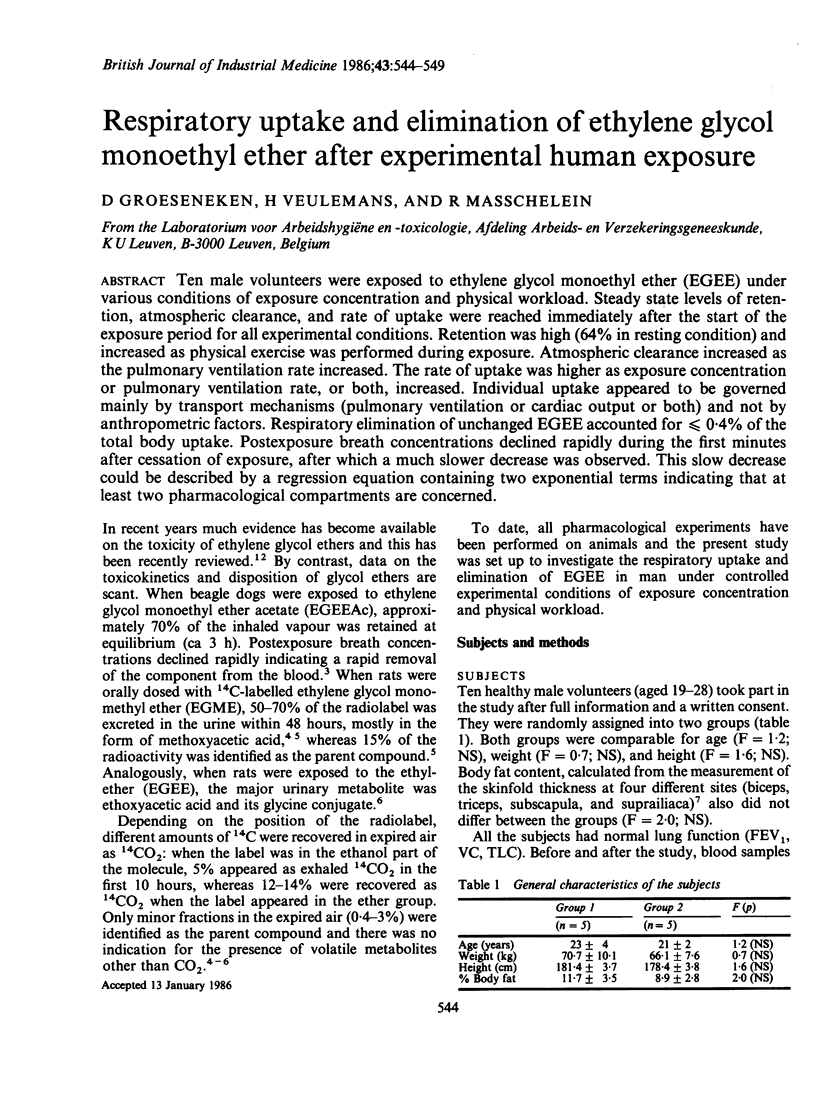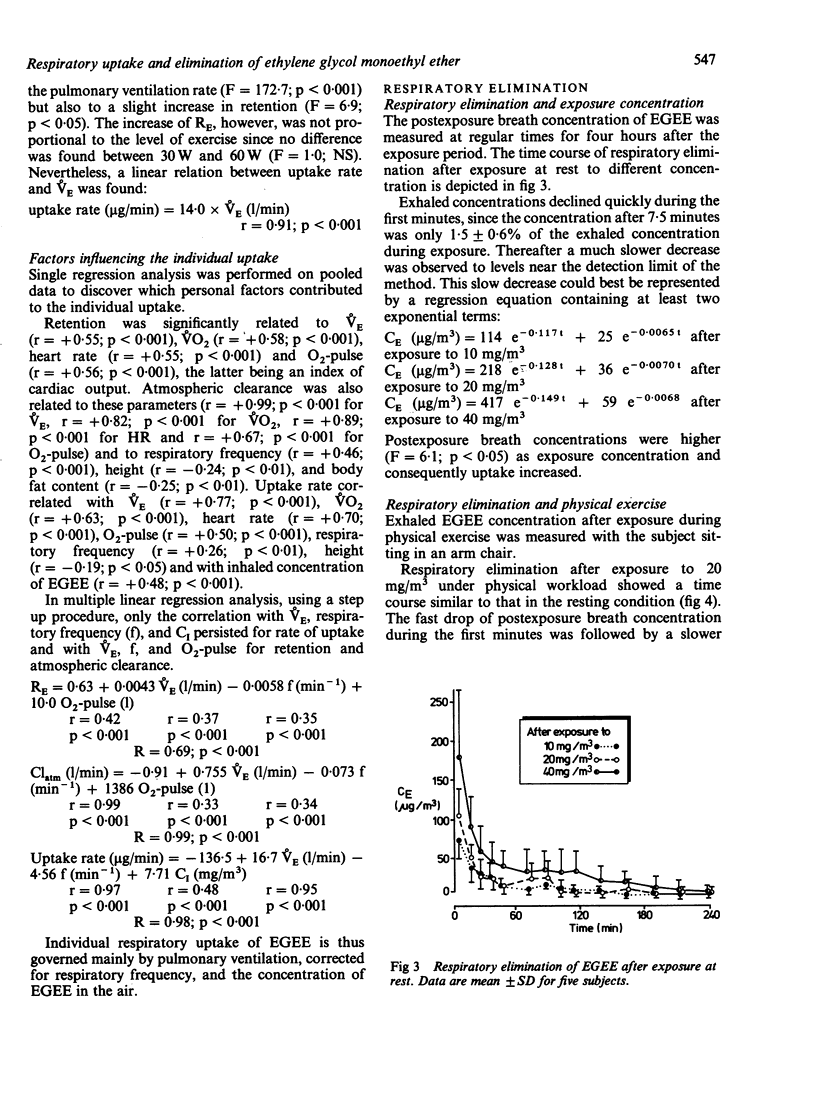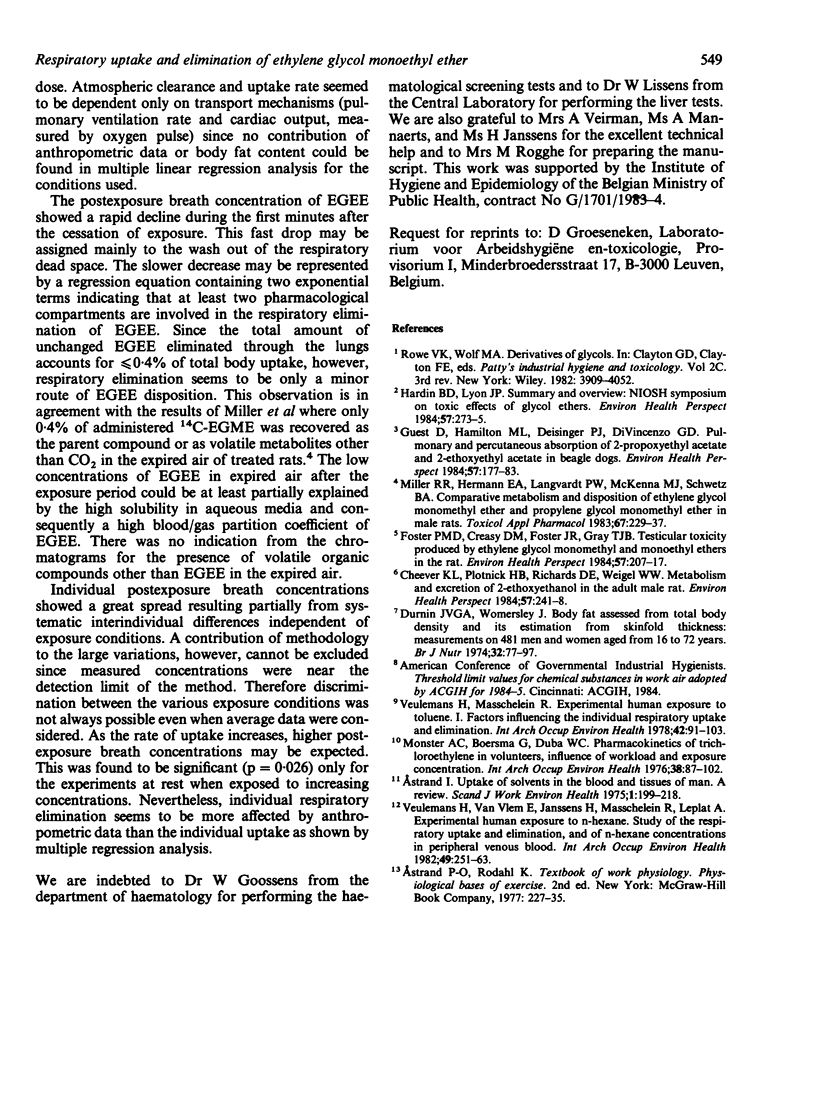Abstract
Ten male volunteers were exposed to ethylene glycol monoethyl ether (EGEE) under various conditions of exposure concentration and physical workload. Steady state levels of retention, atmospheric clearance, and rate of uptake were reached immediately after the start of the exposure period for all experimental conditions. Retention was high (64% in resting condition) and increased as physical exercise was performed during exposure. Atmospheric clearance increased as the pulmonary ventilation rate increased. The rate of uptake was higher as exposure concentration or pulmonary ventilation rate, or both, increased. Individual uptake appeared to be governed mainly by transport mechanisms (pulmonary ventilation or cardiac output or both) and not by anthropometric factors. Respiratory elimination of unchanged EGEE accounted for less than or equal to 0.4% of the total body uptake. Postexposure breath concentrations declined rapidly during the first minutes after cessation of exposure, after which a much slower decrease was observed. This slow decrease could be described by a regression equation containing two exponential terms indicating that at least two pharmacological compartments are concerned.
Full text
PDF





Selected References
These references are in PubMed. This may not be the complete list of references from this article.
- Cheever K. L., Plotnick H. B., Richards D. E., Weigel W. W. Metabolism and excretion of 2-ethoxyethanol in the adult male rat. Environ Health Perspect. 1984 Aug;57:241–248. doi: 10.1289/ehp.8457241. [DOI] [PMC free article] [PubMed] [Google Scholar]
- Durnin J. V., Womersley J. Body fat assessed from total body density and its estimation from skinfold thickness: measurements on 481 men and women aged from 16 to 72 years. Br J Nutr. 1974 Jul;32(1):77–97. doi: 10.1079/bjn19740060. [DOI] [PubMed] [Google Scholar]
- Foster P. M., Creasy D. M., Foster J. R., Gray T. J. Testicular toxicity produced by ethylene glycol monomethyl and monoethyl ethers in the rat. Environ Health Perspect. 1984 Aug;57:207–217. doi: 10.1289/ehp.8457207. [DOI] [PMC free article] [PubMed] [Google Scholar]
- Guest D., Hamilton M. L., Deisinger P. J., DiVincenzo G. D. Pulmonary and percutaneous absorption of 2-propoxyethyl acetate and 2-ethoxyethyl acetate in beagle dogs. Environ Health Perspect. 1984 Aug;57:177–183. doi: 10.1289/ehp.8457177. [DOI] [PMC free article] [PubMed] [Google Scholar]
- Miller R. R., Hermann E. A., Langvardt P. W., McKenna M. J., Schwetz B. A. Comparative metabolism and disposition of ethylene glycol monomethyl ether and propylene glycol monomethyl ether in male rats. Toxicol Appl Pharmacol. 1983 Feb;67(2):229–237. doi: 10.1016/0041-008x(83)90229-6. [DOI] [PubMed] [Google Scholar]
- Monster A. C., Boersma G., Duba W. C. Pharmacokinetics of trichloroethylene in volunteers, influence of workload and exposure concentration. Int Arch Occup Environ Health. 1976 Dec 15;38(2):87–102. doi: 10.1007/BF00378619. [DOI] [PubMed] [Google Scholar]
- Veulemans H., Masschelein R. Experimental human exposure to toluene. I. Factors influencing the individual respiratory uptake and elimination. Int Arch Occup Environ Health. 1978 Nov 15;42(2):91–103. doi: 10.1007/BF01297548. [DOI] [PubMed] [Google Scholar]
- Veulemans H., Van Vlem E., Janssens H., Masschelein R., Leplat A. Experimental human exposure to n-Hexane. Study of the respiratory uptake and elimination, and of n-Hexane concentrations in peripheral venous blood. Int Arch Occup Environ Health. 1982 Feb;49(3-4):251–263. doi: 10.1007/BF00377934. [DOI] [PubMed] [Google Scholar]


